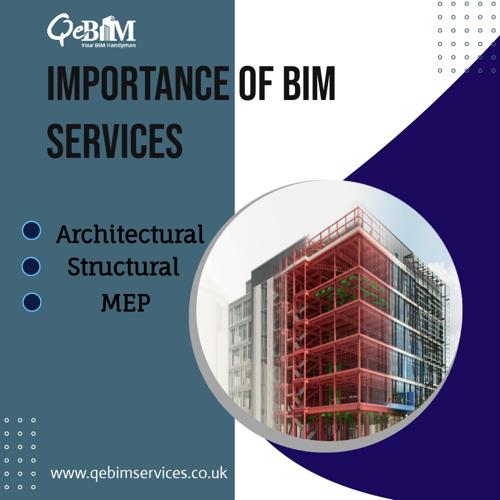BIM services
Contents |
[edit] Introduction
When it comes to designing, building, and operating projects, Building Information Modelling services are used to create & manage data. BIM combines data from various disciplines to produce intricate virtual renderings which are controlled in an accessible cloud infrastructure for authentic collaboration. Utilising BIM suggests improvements, offers more innovative solutions, and lowers the cost of AEC projects.
Building information modelling is a cutting-edge system that assists professionals in architecture building, industrial applications organising, or managing infrastructure projects. Data, technologies, personnel, procedures, and rules constitute the majority of the components of Building information modelling.
[edit] What makes BIM necessary?
Assessing spatial linkages and geographical information, both are part of Building Information Modelling, which goes beyond simple geometrical studies. Knowing all necessary resources' requirements like their numbers, elements, & structures, helps with progress. Moreover, the technique may be applied to capital management, maintenance planning, & facility management.
Infrastructure has grown more sophisticated, flexible, and dependent on new technologies due to globalisation. By enhancing productivity, efficacy & streamlining procedures, this technology links Architectural specialists to assist in designing & constructing decent infrastructure. This aids in optimising resource utilisation, reducing waste, & increasing output.
[edit] Benefits of Building Information Modelling (BIM)
[edit] 1. Enhanced Effectiveness
Construction projects function more efficiently due to BIM's key benefits. It becomes less complicated to handle & quicker to execute every component of pre-construction & development work.
Using Bim technology, architects can generate drawings quickly, while predictors may use Building information models for more precise estimates.
Moreover, BIM designs enable far greater interaction amongst various project participants. It ensures everybody is constantly working with the most recent model because it enables different experts to view BIM blueprints at any time they want to. By doing this, you can minimise mistakes caused by using wrong or inaccurate knowledge.
[edit] 2. Reduce Costs and Wastage
Building information modelling services provide construction companies with a wide range of resources that can assist them in enhancing their workflows before a project starts.
Building information modelling speeds the construction activities, aids in significantly reducing mistakes that may happen during building work, & helps builders choose quality materials. Building information modelling helps contractors reduce the number of wasted resources by strengthening the design processes. And hence, it really can contribute to reducing expenses.
[edit] 3. Better Pricing Predictions
Estimators can produce findings that are far more precise by operating with such a thorough model. A 3-dimensional model gives you a far more incisive strategy to build off of than a two-dimensional design. As a consequence, Pricing Predictions based on models are much more precise and practical. Also, it speeds up the estimation procedure by rendering information & tools more accessible.
BIM can improve more than Pricing Predictions. Quantities elevations are also made simpler by Building information modelling since they provide a more complete framework to work on.
[edit] 4. An improved understanding of the project
A much more accurate three-dimensional view of the project's final result is provided by BIM plans. As a consequence, it is easier for us to see the outcome. It can aid both the customer and the builder in improving their comprehension of the building project.
This aids in both an overall understanding of the structure as well as the prevention of needless reworking. Designers can determine what is working & what has to be changed by examining the three-dimensional designs of a project. Rework is expensive in terms of time & money, so it can be avoided.
[edit] 5. Collaborations & Interaction
Building information modelling is an approach that fosters cooperation. With the use of BIM tools, communication and collaboration are made simple for all construction stakeholders. They have 24/7 accessibility to the latest designs along with every knowledge they want. This lessens the need for meetings at work & delays in workflow. All project participants can work continuously on the project's whole scope. Models, budgets, & architectural ideas all are produced & kept inside one location.
As a result, designers may modify drawings right away, and even when they're not on the work site, contractors may make modifications to the model. A project runs more smoothly and effectively when Collaboration & Interaction are enhanced.
[edit] 6. Minimal Risk
Designing with BIM support is simpler & less dangerous. This strategy promotes stronger contractor involvement. It can thereby lower tendering systematic risks. This enables a better overall perspective on the task before the commencement of construction.
This leads to improved safety procedures, reduced resource waste, fewer misunderstandings, etc. Furthermore, there isn't a chance of vendors utilising obsolete data. Businesses may decrease the cost of insurance as well as the likelihood of disputes by using BIM technology. BIM is therefore very helpful for reducing expenses & managing hazards.
[edit] 7. Improved outcomes
The improvement of a design & construction procedure is the main goal of BIM support. This usually yields a construction & final product of superior quality. Construction companies can perform higher-quality work with efficient coordination and more precise observations. The focus on the construction's look is increased because builders can envision the structure early. BIM generates constructed resources of a better standard as a result.
[edit] Conclusion
All construction companies use BIM as a comprehensive strategy for organising, executing, & overseeing development ventures. Building information modelling could help all participants who are involved in a building endeavour in a variety of ways. It ultimately produces better outcomes.
As more experts become cognisant of the benefits of this technology, the building sector is swiftly shifting towards a more BIM-focused strategy. Hence, implementing BIM can lead to increased profitability & performance.
[edit] Related articles on Designing Buildings
- Asset information requirements AIR.
- BIM.
- BIM and facilities management.
- BIM articles.
- BIM dimensions.
- BIM execution plan.
- BIM glossary of terms.
- BIM maturity levels.
- BIM resources.
- Building drawing software.
- Construction Operations Building Information Exchange (COBie).
- Collaborative practices.
- Common data environment.
- Data drops.
- Digital information.
- Digital model.
- Government Soft Landings.
- Improving health and safety using BIM.
- Industry Foundation Classes.
- Information management.
- MEP BIM and the building lifecycle.
- Revit.
- Soft landings.
- Uniclass.
Featured articles and news
RTPI leader to become new CIOB Chief Executive Officer
Dr Victoria Hills MRTPI, FICE to take over after Caroline Gumble’s departure.
Social and affordable housing, a long term plan for delivery
The “Delivering a Decade of Renewal for Social and Affordable Housing” strategy sets out future path.
A change to adoptive architecture
Effects of global weather warming on architectural detailing, material choice and human interaction.
The proposed publicly owned and backed subsidiary of Homes England, to facilitate new homes.
How big is the problem and what can we do to mitigate the effects?
Overheating guidance and tools for building designers
A number of cool guides to help with the heat.
The UK's Modern Industrial Strategy: A 10 year plan
Previous consultation criticism, current key elements and general support with some persisting reservations.
Building Safety Regulator reforms
New roles, new staff and a new fast track service pave the way for a single construction regulator.
Architectural Technologist CPDs and Communications
CIAT CPD… and how you can do it!
Cooling centres and cool spaces
Managing extreme heat in cities by directing the public to places for heat stress relief and water sources.
Winter gardens: A brief history and warm variations
Extending the season with glass in different forms and terms.
Restoring Great Yarmouth's Winter Gardens
Transforming one of the least sustainable constructions imaginable.
Construction Skills Mission Board launch sector drive
Newly formed government and industry collaboration set strategy for recruiting an additional 100,000 construction workers a year.
New Architects Code comes into effect in September 2025
ARB Architects Code of Conduct and Practice available with ongoing consultation regarding guidance.
Welsh Skills Body (Medr) launches ambitious plan
The new skills body brings together funding and regulation of tertiary education and research for the devolved nation.
Paul Gandy FCIOB announced as next CIOB President
Former Tilbury Douglas CEO takes helm.
UK Infrastructure: A 10 Year Strategy. In brief with reactions
With the National Infrastructure and Service Transformation Authority (NISTA).
























